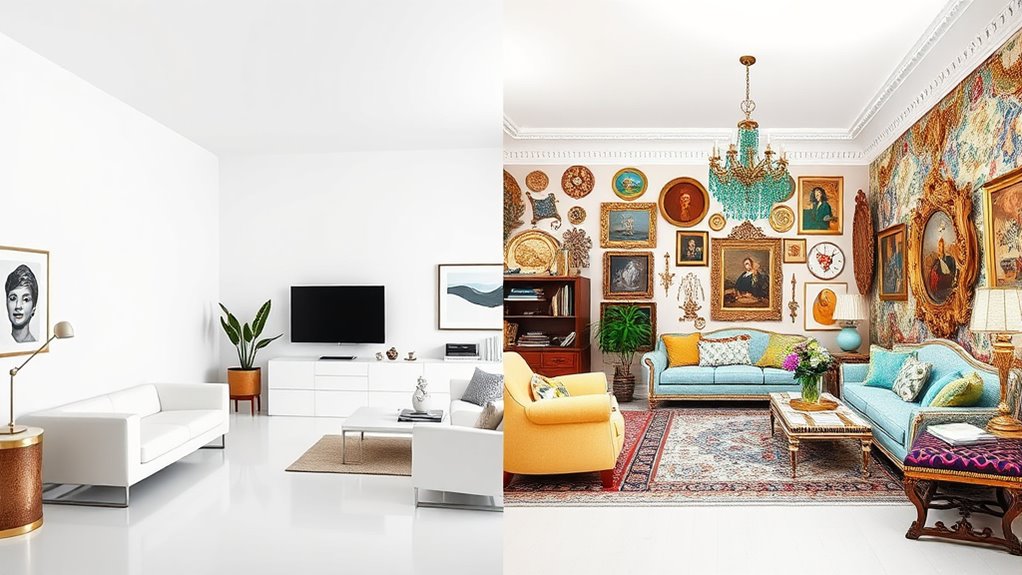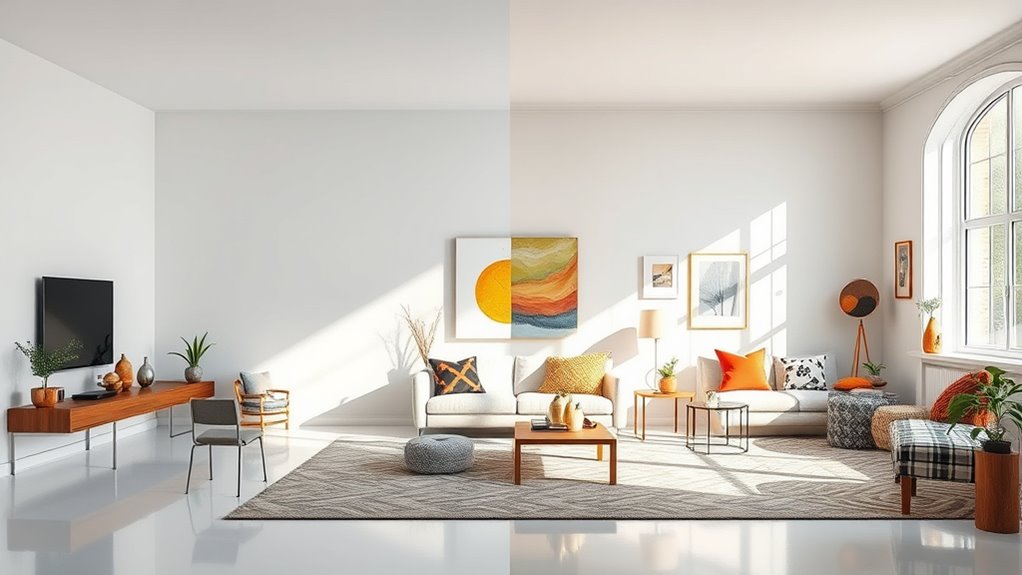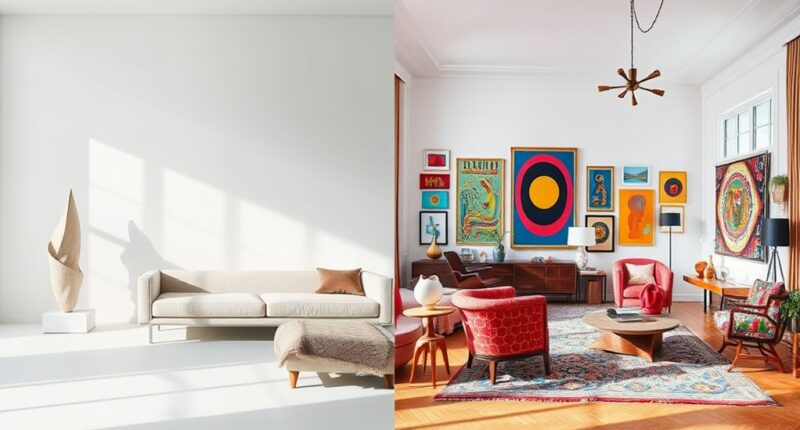Choosing between minimalism and maximalism reveals a lot about your personality and lifestyle. If you prefer calm, organized spaces that promote peace and clarity, minimalism might suit you best. If you love vibrant, layered environments full of character and energy, maximalism could be your style. Both styles reflect different ways of expressing yourself and supporting your daily routine. To discover which fits you more, explore how each style resonates with your personality and living habits.
Key Takeaways
- Consider if you prefer calm, uncluttered spaces (minimalism) or vibrant, layered environments (maximalism).
- Reflect on whether you value simplicity and organization or enjoy bold patterns and eclectic decor.
- Assess your personality traits: peace and clarity align with minimalism; creativity and energy suit maximalism.
- Think about your lifestyle: relaxed routines favor minimalism; social, lively settings lean toward maximalism.
- Decide if you want a harmonious, neutral palette or a colorful, textured space full of personality.
The Principles Behind Each Style

Understanding the principles behind minimalism and maximalism helps you appreciate their distinct approaches to decor. Minimalism emphasizes simplicity, clean lines, and functionality, often using neutral color palettes with subtle color symbolism to evoke calm and order. It’s influenced by cultural ideas of restraint and clarity, stripping away excess to focus on essentials. Maximalism, on the other hand, celebrates abundance, bold patterns, and vibrant colors, reflecting cultural influences that value storytelling and personal expression. This style embraces a layered, eclectic aesthetic, where contrasting colors and textures create visual excitement. While minimalism seeks to create serene spaces through restraint, maximalism invites you to explore a rich tapestry of colors and cultural motifs, expressing personality and history through an exuberant, unapologetic approach to decor. Incorporating a variety of textures and patterns further enhances each style’s unique character and emotional impact.
How Minimalism Reflects Calm and Clarity

Minimalism achieves its sense of calm and clarity through deliberate simplicity. By limiting clutter and focusing on essential elements, you create a space that promotes a calm ambiance. When every item serves a purpose, your environment feels organized and intentional, reducing visual noise. This emphasis on clean lines and neutral tones enhances visual clarity, making your space easier to navigate and more soothing to the eye. As a result, you’re less overwhelmed and better able to focus on what truly matters. Minimalist decor invites tranquility by stripping away distractions, allowing your mind to relax and breathe. Incorporating a harmonious color palette can further enhance the sense of peace and balance in your environment. If you value peace and straightforwardness, this style naturally reflects those qualities, helping you cultivate a serene, clutter-free environment that nurtures calmness.
The Expressiveness of Maximalist Spaces

Maximalist spaces thrive on bold color combinations that catch the eye and evoke emotion. Eclectic decorative elements add layers of personality, making each room uniquely expressive. Together, these features create environments that communicate your personality loud and clear.
Bold Color Combinations
Bold color combinations serve as the heartbeat of maximalist spaces, turning walls, furniture, and accessories into vibrant statements. With bold color combinations, you create a dynamic environment that reflects your personality and love for self-expression. These vibrant room palettes mix unexpected hues, from jewel tones to neon shades, creating a lively atmosphere. Instead of sticking to neutral tones, you embrace contrasts and juxtapositions that energize the space. Mastering this style means confidently pairing colors to avoid chaos and instead achieve harmony. Whether you choose rich reds with emerald greens or vibrant blues with sunny yellows, your space becomes a visual celebration of individuality. This fearless approach to color makes your home uniquely yours, capturing the essence of maximalist decor’s expressive spirit. Incorporating color psychology can help you select combinations that evoke the desired mood and atmosphere in your space.
Eclectic Decorative Elements
Eclectic decorative elements breathe life into maximalist spaces by blending diverse styles, textures, and eras into a cohesive whole. This approach allows you to express your personality boldly through patterns and textures that evoke emotion. Statement pieces serve as focal points, showcasing your unique taste and creativity. Incorporating color temperature adjustments can further enhance the visual harmony of eclectic decor by balancing warm and cool tones throughout the space.
Personalities That Thrive in Simplicity

If you prefer a space that feels organized and calm, minimalism might suit you best. You appreciate clean lines and a clutter-free environment that promotes relaxation. Valuing functionality over excess, you find peace in simplicity and purpose. Incorporating simple Halloween decorations can enhance your space without overwhelming its minimalist aesthetic.
Organized and Calm
People with organized and calm personalities often find that minimalism perfectly aligns with their need for clarity and peace. You thrive in spaces where color coordination is subtle and harmonious, creating a soothing environment. Your furniture arrangement is intentional, emphasizing functionality without clutter. The simplicity allows your mind to breathe and focus.
Consider these aspects:
- Neutral tones that promote relaxation and balance.
- Clean lines in furniture to enhance visual calmness.
- Uncluttered surfaces to maintain serenity.
- Thoughtful placement of each piece, boosting a sense of order.
Your decor naturally reflects your inner peace, making spaces feel open and inviting. Minimalism isn’t just a style; it’s a reflection of your personality.
Appreciates Clean Lines
Clean lines define spaces that feel effortless and refined, making them ideal for those who thrive on simplicity. You appreciate interior symmetry, which creates a balanced and harmonious look. Furniture shapes are sleek and straightforward, avoiding ornate details or clutter. Your space emphasizes open, uncluttered areas where each piece serves a purpose. You prefer a minimal aesthetic that highlights craftsmanship and form, rather than decoration. The focus on clean lines helps you achieve a sense of calm and order, allowing your environment to feel inviting yet uncluttered. This style aligns with your personality by fostering tranquility through simplicity and intentional design. By prioritizing clean lines, you create a space that’s both functional and visually soothing, reflecting your appreciation for effortless elegance. Incorporating remote collaboration tools can also facilitate creative projects and brainstorming, enhancing the sense of openness and clarity in your environment.
Values Functionality
Prioritizing functionality in your space means selecting pieces that serve multiple purposes and simplify daily routines. You value functional beauty and practical aesthetics, where every item has a clear purpose. Your environment feels calm and organized, reducing stress and saving time. When choosing decor, you look for versatility and practicality over excess.
Here are four ways you thrive with simplicity:
- You choose furniture that doubles as storage, maximizing space.
- You prefer clean, clutter-free surfaces that promote focus.
- You favor neutral tones and simple designs that evoke calm.
- You invest in quality pieces that last, emphasizing durability over trendiness.
Your personality appreciates a space where form follows function, blending beauty with practicality effortlessly.
Characteristics of Those Who Embrace Rich Complexity

Those who embrace rich complexity in their decor often have a keen eye for detail and a love for layered textures and vibrant colors. You enjoy creating visual interest through diverse patterns, intricate accessories, and bold hues. Your space reflects a dynamic personality, blending various elements to tell a story. You thrive on the energy of layered accessories and the tactile appeal of rich textures, making each corner inviting and stimulating. This appreciation for hidden mysteries and the enigmatic world around us often influences your eclectic style, adding an extra layer of intrigue to your environment.
Creative Ways to Incorporate Elements of Both Styles

Blending minimalism and maximalism can create a dynamic and personalized space that balances simplicity with rich visual interest. To achieve this, try layering textures like smooth fabrics with rougher surfaces, adding depth without clutter. Mix patterns—stripes with florals, polka dots with abstract designs—to spark energy while maintaining cohesion. Here are some creative ideas:
- Use a neutral base and add bold, patterned accents to keep things lively.
- Incorporate textured throws or rugs to evoke warmth and richness.
- Display a curated collection of statement pieces alongside clean-lined furniture.
- Combine minimalist artwork with maximalist decor elements for a balanced look.
Deciding Which Style Resonates With Your Lifestyle

Choosing between minimalism and maximalism often depends on how each style aligns with your daily routines, personality, and preferences. If you prefer simplicity and calm, minimalism’s clean lines and neutral colors may suit you best. Conversely, if you thrive on energy and visual interest, maximalism’s vibrant colors and layered furniture choices could be a better fit. Consider your lifestyle’s pace: do you want a clutter-free space for relaxation or a dynamic environment for socializing? Use the table below to evaluate:
| Lifestyle Aspect | Style Match |
|---|---|
| Preference for simplicity | Minimalism |
| Love for vibrant spaces | Maximalism |
| Comfort with clutter | Maximalism |
Your choice should reflect your personality and how you want your space to influence your daily life. Additionally, understanding decor styles can help you make an informed decision that truly matches your personality.
Frequently Asked Questions
Can Combining Minimalism and Maximalism Create a Balanced Home?
You can definitely create a balanced home by combining minimalism and maximalism. Use layered textures to add depth and visual interest, while maintaining a cohesive look through careful color coordination. Keep the overall space uncluttered, but incorporate bold patterns or unique accessories that reflect your personality. This blend allows you to enjoy the simplicity of minimalism with the vibrancy of maximalism, resulting in a harmonious and personalized environment.
Which Decor Style Is More Suitable for Small Spaces?
In small spaces, you should prioritize space optimization with smart furniture choices. Opt for multi-functional pieces like beds with built-in storage or fold-away desks to maximize your area. Minimalism tends to be more suitable, as it reduces clutter and creates a sense of openness. However, if you prefer bold, vibrant decor, a maximalist approach with thoughtful organization can also work, as it adds personality without sacrificing functionality.
How Do I Transition Between Minimalism and Maximalism?
Thinking of switching styles? Well, why not blend them like a smoothie—layered textures and color harmony are your secret ingredients. Start by adding a few statement pieces to a minimalist base, then gradually introduce bold accents and patterns. It’s about balance, not chaos. Embrace the art of curated excess or simplified elegance, and remember: your space should reflect your personality, not just a decorating rulebook.
Are There Cultural Influences That Favor One Style Over the Other?
You might notice that cultural aesthetics and regional preferences influence your decorating style. Some cultures favor minimalist designs that emphasize simplicity and tranquility, while others embrace maximalism’s rich textures and vibrant colors. These regional influences shape what feels authentic and comfortable to you. By exploring your cultural background, you can better understand whether a minimalistic or maximalist approach aligns with your personality and environment.
What Are Common Misconceptions About Minimalism and Maximalism?
You might think decor myths define minimalism or maximalism, but they’re just stereotypes. People often assume minimalism means boring, or maximalism is cluttered, yet both styles celebrate personal expression. These stylistic stereotypes oversimplify what’s truly possible. Remember, your space should reflect your personality, blending simplicity or abundance as you see fit. Don’t fall for these decor myths—trust your instincts and create a space that feels right for you.
Conclusion
Ultimately, choosing between minimalism and maximalism boils down to knowing yourself. Whether you prefer a peaceful haven or a vibrant tapestry of life, the right style should feel like second nature. Don’t be afraid to blend elements or switch things up—after all, variety is the spice of life. Trust your instincts, and remember, sometimes you have to go against the grain to truly find your perfect match.









